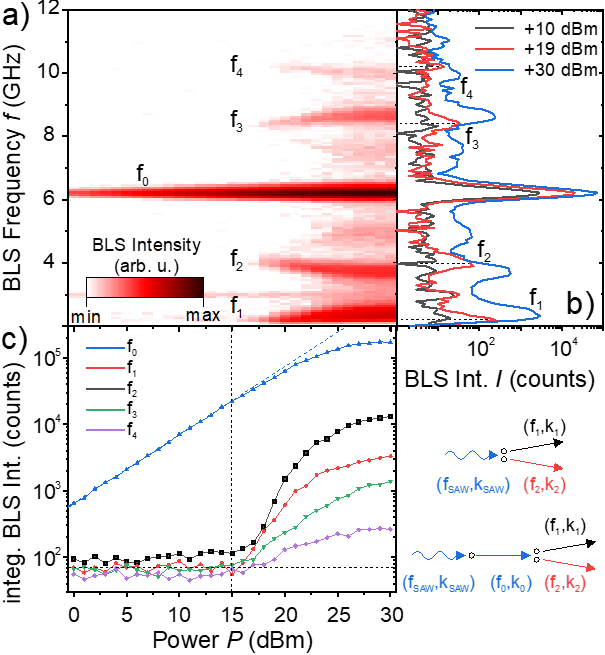
- This event has passed.
Magnon-phonon coupling going nonlinear and nano-scaled
June 8 , 13:00 – 14:00
Speaker: Prof. Philipp Pirro
Affiliation: Fachbereich Physik and Landesforschungszentrum OPTIMAS, Technische Universität Kaiserslautern, Germany
Link to MS Teamas meeting
Magnetoelasticity, the interaction between magnetism and elastic strain, is a promising mechanism for compact and energy-efficient spintronic devices. In particular, the interaction between the fundamental excitations in a magnetic solid, the magnons and the phonons, is of high relevance for future hybrid devices for data processing and computing.

In this lecture, I first present results on nonlinear magnon-phonon processes in strongly excited thin film microstructures. As an example, the generation of linear magnons [1] and magnon instabilities [2] by coherent surface acoustic waves (SAW) in a thin metallic ferromagnetic film of CoFeB is discussed. Micro-focused Brillouin light scattering spectroscopy (BLS, see Figure) and analytical modelling combined with micromagnetic simulations are used to reveal the different instability processes by identifying the involved mechanisms and magnon modes. Depending on the experimental conditions, a four-magnon instability of the magnon mode or a direct first-order parametric phonon-to-magnon instability is observed.
Second, I present results on magnon phonon-interaction in multiferroic nano devices composed of piezoelectric elements with lateral dimensions down to 80 nm which are mechanically coupled to magnon waveguides made of magnetostrictive metals. Micro-focused BLS reveals the generation of both propagating phonons as well as magnons when microwave electric fields are applied to these capacitive structures. A comparison to inductive excitation mechanisms using standard microwave antennas shows clear differences of this capacitive, magneto-elastic excitation mechanism.
Our results indicate that magnetoelectric systems are very promising as scalable and energy efficient sources for spin waves.
This work has been supported by the EU Horizon 2020 research and innovation program within the CHIRON project (contract no. 801055).
[1] M. Geilen et al., “Fully Resonant Magneto-elastic Spinwave Excitation by Surface Acoustic Waves under Conservation of Energy and Linear Momentum”, arXiv:2106.14705 accepted in Applied Physics Letters [2] M. Geilen et al., “Parametric Excitation and Instabilities of Spin Waves driven by Surface Acoustic Waves” arXiv:2201.04033 (2022).Chairman: Prof. Jarosław W. Kłos
Theme by Themesmob
